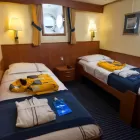- Ship
- 4 Breakfasts, 4 Lunches, 4 Dinners
With a long history of early oceanic exploration, the Tristan da Cunha archipelago has seen its share of shipwrecks. The most famous was the British Blenden Hall, destroyed in 1821 en route to Bombay (now Mumbai). Fortunately, all but two aboard survived. Isolated and with a rugged, volcanic terrain, most of these small islands host an abundance of birdlife and remain uninhabited to this day.
Together, Gough and Inaccessible Islands comprise two wildlife reserves and a UNESCO World Heritage Site, making them the most undisturbed islands in the South Atlantic. Zodiac excursions take you close to the towering cliffs that support large seabird colonies. Bird lovers marvel at the variety of unique species that include the Inaccessible rail (the world’s smallest flightless bird, and more easily heard than seen), Gough bunting, great shearwater, sooty albatross, Atlantic yellow-nosed albatross, Atlantic petrel, and endemic spectacled petrel, as well as the endemic Tristan albatross, and the Tristan skua, thrush and bunting. Both islands also host colonies of northern rockhopper penguin (locally called pinnamins) and large numbers of subantarctic fur seals, so have your camera ready to capture these incredible creatures. With the sheer range of birdlife here, it’s no wonder that much of the British overseas territory of St. Helena, Ascension and Tristan da Cunha has been identified by BirdLife International as Important Bird Areas!
Ever wonder what the most remote place on the planet is like? Just ask one of the friendly residents of Tristan da Cunha Island, a chunk of volcanic rock smack dab in the middle of nowhere! All descendants of the original settlers, some 260 British citizens, live here, in the village of Edinburgh of the Seven Seas—an astounding 1,510 miles (2,430 km) from the nearest inhabited neighbor, St. Helena Island. As you wander the lanes of The Settlement (as islanders call the village) or chat with locals at the lone pub, discover why escaping to Tristan da Cunha is akin to traveling back in time, where you find an old-fashioned hospitality unlike anywhere else. A visit to the world’s most remote post office yields a delightful collection of Tristan da Cunha stamps, illustrating everything from fur seals to a retrospective of Queen Elizabeth II’s dress styles to the 1816 landing of a British garrison. It’s a must-stop for philatelic enthusiasts.
Just a short cruise away, Nightingale Island awaits. Although only one square mile (3.2 sq. km), this active volcano, which last erupted in 2004, is a prolific breeding ground for more than a million seabirds.
























